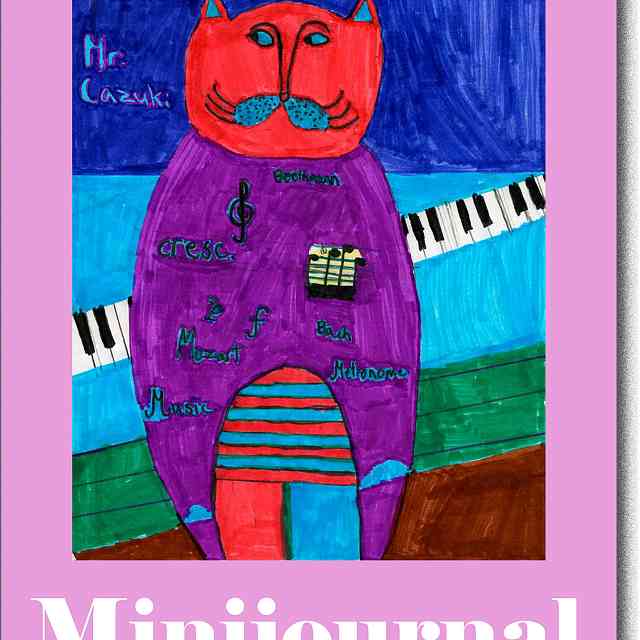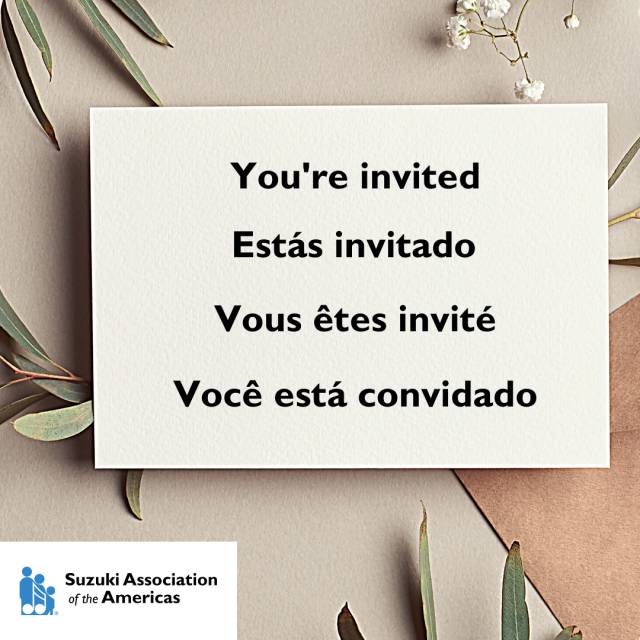This article is part one in a series about memory and music.
The Suzuki philosophy wholeheartedly embraces memorization as an important tool for the young student. Indeed, the Suzuki approach gets many things right in light of new research and understanding of how memorization works. If you’re like me, however, teaching and learning are not static—you’re always wanting to discover fresh approaches, incorporate a deeper understanding of new educational theory, and find new ways to communicate ideas.
Memory used to be incredibly important, but now we depend much less on our memories and instead use lists, write memos and emails, and use Google to answer all our questions. To help put this in context by comparing our dependence on outside memory rather than internal memory, here is a thought-provoking quote from Joshua Foer:
Imagine waking up tomorrow and discovering that all the world’s ink had become invisible and all our bytes had disappeared. Our world would immediately crumble. Literature, music, law, politics, science, math: Our culture is an edifice built of externalized memories… The externalization of memory not only changed how people think; it also led to a profound shift in the very notion of what it means to be intelligent. (Foer 2011, 19)
Memory is such a valuable tool, and musicians rely on it in a way that many other professionals do not. By learning more about memory and the different types of memorization, we can become more efficient musicians.
What is memory?
Our brain processes memories in two ways: our short-term working memory and our long-term storage memory. Short-term memory is used for tasks like remembering a shopping list, while long-term memory helps us commit facts or songs to memory in a deliberate fashion. This is an efficient division of resources since memories that require easy access for a short time do not take up residence in the brain. “In fact, dividing memory between short-term and long-term stores is such a savvy way of managing information that most computers are built around the same model,” Joshua Foer writes. (Foer 2011, 56-57)
Once most neurotypical people commit a memory to long-term storage, it is never really lost. However, there are two important qualifications to this statement, according to Benedict Carey (Carey 2015, 36-37):
-
The retrieval strength, or how easily we can access the memory, can fade if we don’t use that information. The memory is still there but we can’t find it—although that doesn’t mean that the path to that memory cannot be opened up again at some point in the future.
-
Every time we retrieve a memory, we change it. The act of accessing a memory, then, causes a change both in terms of its retrieval strength and the actual content of the memory itself.
I didn’t realize what was happening in my brain when I was a young student, and my guitar teachers told me to simply “play the piece over and over again until your fingers know what to do.” I faithfully tried to do this for years but found that it didn’t always work. No matter how many hundreds of times I practiced, my fingers just didn’t do what I was hoping they would do. This sort of memory practice, which I haven’t found reliable under the intense pressures of high stakes performances, uses what is known as muscle memory.
What is muscle memory?
As any experienced performer knows, there are many pieces of music that repeat material. The first time you use a hand shape, the piece goes in one direction. The second time you repeat it the piece goes in a totally different direction—and if you aren’t carefully monitoring the piece, but instead are playing it in automatic pilot, then you can go down the wrong path very easily indeed. Automatic pilot for musicians is another name for muscle memory, because conscious thought has been excluded. Instead, we are relying on pre-learned physical habits. Muscle memory, also called motor learning, is just that: it exists outside of conscious thought and is stored in different spots than the working memory and storage memory locations discussed above.
It is useful to think of the physical skills of playing an instrument within the much broader category of any motor function within the body. A motor function is any movement that requires muscular activation, such as walking or lifting a glass of water. Recent studies of how we learn motor skills demonstrate that there are three stages before a movement sequence becomes automatic. The first stage requires explicit, intentional focus and utilizes the working memory (Marinelli et al. 2017, 1128) as a new skill is learned. Two more phases then occur, where movements go from requiring intentional focus to requiring less attention. (Marinelli et al 2017, 1129). Some motor functions, such as walking or drinking a glass of water, require such little attention that people with typical motor function can do them without explicit attention. They can even do other things at the same time. This is what takes place when a Suzuki teacher is able to play an accompaniment at the front of the room during a group class and sing the student part at the same time. The musical accompaniment is being performed implicitly while all the conscious attention is directed towards the student activity explicitly. Creating the ability to play pieces without the need for conscious attention is no doubt useful in some circumstances, but it is not the answer to every musical need.
There are many complex movements done automatically throughout the body through the combination of three motor systems that are always interacting and adjusting each other—the balance, posture, and movement systems. Familiar and expected tasks become implicit because of repetition, but it is possible to consciously intervene in any movement your body does. For example, I can decide to change the manner in which I raise my arm, but it slows me down because consciously taking control of a movement enlists the cortex or higher brain functions. Using predetermined patterns is faster, more efficient, and doesn’t burn up so many of our limited energy resources. Automatic pilot for musicians, then, can be usefully compared to setting off a series of implicit motor loops and waiting to see if they fire off in the order that they usually follow.
The problem is that there are multiple systems working in a collaborative effort, constantly making minute adjustments to the body at all times. Because of this complexity, the limitations of relying on muscle memory for a performing musician can be quite dramatic; if you change the circumstances of the performance then you can completely lose access to the muscle memory. For example, if you change a fingering pattern accidentally to a different finger, then the whole physical chain of motion can fall apart. If you try to change your hand position to create a healthier and more sustainable playing practice, the whole muscle memory chain can fall apart. If a spotlight is shining in your eyes as a distraction and it causes a hesitation, then again the whole muscle memory chain can fall apart. All these things change the task, so the muscle memory cannot perform in the same way.
The body develops motor habit patterns because it is a faster and more energy-efficient use of bodily resources to not engage the upper brain functions or the cortex. The brain loves, most of all, to operate using predictive, pre-existing loops that don’t require conscious intervention, as outlined in recent neuroscience. According to Lisa Feldman Barrett (Feldman Barret 2017, 56-68), the brain creates our reality through relentless prediction, constantly sifting through previous experiences, and making guesses about how to respond or proceed. It’s astounding how much of the activity in the higher brain is a recycling of past experiences:
Through prediction, your brain constructs the world you experience. It combines bits and pieces of your past and estimates how likely each bit applies in your current situation. … In short, your experience right now was predicted by your brain a moment ago. Prediction is such a fundamental activity of the human brain that some scientists consider it the brain’s primary mode of operation (Feldman Barret 2017, 59).
Some things we do are entirely predictive—daydreaming and illusions are more obvious; less obvious is any perception that matches our prediction. In other words, it is only when our predictions fail and we have to compensate that any learning takes place. To take one of the many examples in Feldman Barrett’s book, if you are walking along a path and what your brain predicts is a stick actually ends up being a snake, then sensory input becomes overwhelmingly important as you physically react to this new and unexpected scenario. Sensory input is direct information requiring immediate interpretation—our senses tune, feed, and correct our predictions. If comfortably predictive activity is taking place (is this reminding anyone else of bored, mindless review?) then there is no learning taking place.
Incorporating mindfulness practices into review (and performances too)—staying with the piece mentally rather than checking out—can create meaningful learning experiences that help to strengthen our depth of knowledge about a piece of music that we have played, even if we have played it a thousand times. Perhaps such mindful repetition can also reduce the sheer number of times that we or our students have to repeat material in order to learn it. To do this, we need much more than a reliance on simple repetition to give ourselves and our students a robust memorization practice and confidence in performance. This is where audiation comes in.
The role of audiation techniques
For the purposes of this paper, I define audiation not just as the process by which the brain gives meaning to musical sounds, but any process that promotes the organization and mapping of musical works away from the instrument, promoting the understanding of structure, form, texture, and relationship to scales. Audiation as a tool for music theory was developed by Edwin Goodwin, but here I use the term to describe a conception of a song (or a piece from the repertoire) that lives successfully and completely within the head—you don’t need the physical habit of playing an instrument to help along the memory processes.
I once heard of a violinist who sat in a train and learned a new piece of music by simply reading the music without his instrument. When the train ride was over, he could play the piece on his instrument in its entirety. When I heard this, I remember thinking that this skill was unattainable for someone like me and the province of the rare “genius.” In the years since then, I’ve come to realize that I can actually help my students by employing audiation strategies to make this sort of skill attainable. I’ve also come to realize that I don’t believe in “genius.” Rather, I believe in a combination of exposure, education, opportunity, and hard work—those are processes I can help along as a Suzuki teacher.
You can teach audiation skills as you can teach sight-singing. It is a layered process that begins with intimate familiarity and comfort in scales. Audiation is also rooted in singing; the earlier and more frequently students sing and play on their instruments, the better musical relationships develop. When a young child attempts to sing a pitch and then corrects that pitch, there is an actual physical change that takes place within the body because the adjustment of the vocal cords is literally embodied. The relationships between pitches is clarified and deepened by early exposure to singing through what is termed the auditory kinaesthetic feedback loop by Kodaly Scholar Anna Kalman. The younger your students begin pitch matching through singing, the easier all other musical tasks become.
It can be useful to think of audiation as having stages, and while some institutes and educators have spent quite a bit of time dividing audiation into levels, I will simply discuss a high-level audiation skill: the ability to think a pitch (and when more sophisticated, multiple pitches) then map that pitch directly on to the instrument without having to test it out first. Why do we want to do this? It doesn’t just make improvisation easier or allow a deaf student to become the next Beethoven and map out entire symphonies in their heads. Rather, for me, the significance is that employing audiation practices breaks autopilot. It is a conscious engagement with the material.
Here is a short list of group class games that employ audiation strategies, though every teacher will have their own variations and suggestions:
-
Scale games: Play scales securely as a round (helpful for understanding intervals), leaving out particular notes, using various rhythms.
-
“Air guitar”: Play a song about a centimeter away from the strings with both hands. I always sing it as we are playing it.
-
“Swapping phrases”: Pass parts of the song around the room (great opportunity to discuss phrases and the form of the song).
-
Silent playing to loud: Use a particular cue to switch from playing out loud to playing in your head. In this game, the song keeps going even if you aren’t playing it.
-
Stop and start: Pause the song in strange places and see if it can be picked up again at that same spot—I usually have one of the kids pick an obnoxious noise as the signal.
-
“Don’t play on one particular note” (e.g. all the B’s in Aunt Rhody are silent): This one takes a lot of preparation.
-
“Left hand/right hand”: They choose which hand they want to play and then I come around the back and play the other hand for them.
Audiation practices force mindfulness by engaging the brain, not just the fingers. The first time a student tries audiation, it will probably be slow going and hard. But the rewards are great. We have to expect slowness when forming new connections in the brain. Armed with the knowledge that audiation practices break automatic pilot syndrome, the next question is, what do we now know about how memory works that can further help along memorization processes? Part two of this series will focus on new research into maximizing our memorizing potential and practical applications in the music studio.
References:
Cacciatore, Tim. 2000. Science and Alexander: Towards a Common Understanding Direction Magazine.
Carey, Benedict. 2015. How We Learn: Throw out the rule book and unlock your brain’s potential London: Random House
Doidge, Norman. 2015. The Brain’s Way of Healing: Stories of Remarkable Recoveries and Discoveries. London: Penguin Books
Feldman Barrett, Lisa. 2017. How Emotions are Made: the Secret Life of the Brain. London: MacMillan.
Foer, Joshua. 2011. Moonwalking with Einstein: The Art and Science of Remembering Everything. New York: Penguin Books
Marinelli, Lucio and Quartarone, Angelo et al. 2017. “The Many Facets of Motor Learning and Their Relevance for Parkinson’s Disease” Clinical Neurophysiology 128. 1127-1141.









